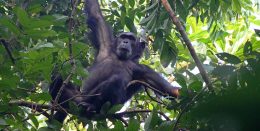Chimp trekking is quite unlike any of the traditional forms of safari. Chimpanzee trekking is a challenging experience and yet a truly magical adventure. Here you are on your feet throughout and in awe inspiring forest that bares no resemblance to anything you will have encountered elsewhere in the country.
Sharing more than 95% of our genes, chimpanzees are as individually unique as humans. They are highly sociable animals, living in groups of anywhere between 15 and 80 members. Like gorillas, these groups are led by a dominant male. They are capable of both bipedal (two legged) or quadruped (knuckle-walking) movement. Chimpanzees primarily eat fruits and other plants, but are actually omnivores capable of digesting insects, eggs and meat. Their diet is almost as varied as the human diet.
Gombe Stream and Mahale Mountains National Parks in western Tanzania, bordering Lake Tanganyika, are home to some of Africa’s last remaining wild chimpanzees (chimps). Chimpanzees are classed as one of the world’s endangered species. All the treks are accompanied by a park guide at all times and governed by strict health, park regulations and code of conduct, to safeguard park visitors and the chimps.
Mahale Mountains National Park
There are few places left on earth that might rightfully be called Eden, and Mahale Mountains National Park in western Tanzania is one of them. The park is named for the beautiful Mahale Mountains towering over the clear, blue waters and white sand beaches of the peripheral Lake Tanganyika, and it is also probably the best place in the world for chimp safaris! Like other Tanzania Western Circuit Parks, Mahale is exceedingly remote, tricky to access, and costly to visit – but it is very different from anything else in Tanzania, and totally magical.
Mahale Mountains National Park is one of the most picturesque places in Tanzania. The park borders Lake Tanganyika, one of the oldest and deepest lakes in the world. Getting to the park is an adventure as it is accessible only by air and boat. There are no roads in the park, only forest paths through the lush vegetation. This park is a hiker’s paradise, but most importantly it is a chimpanzee paradise. Mahale is a haven for primates, with chimpanzee trekking one of the prime reasons for visits. There are also other wildlife animals inside the park. Mahale is not just about chimpanzee-trekking, it offers the perfect balance of wildlife viewing as well as relaxing at the lake. Kayaking, snorkelling and fishing on the clear waters of Lake Tanganyika adds an extra dimension to a visit to Mahale. For those looking to spend more time in the forests, hiking is an option. Climb (2-3 days) to the peak of the Mahale Mountains, Mt. Nkungwe (2,462 m).
Gombe Stream National Park
Renowned through the work of Dr. Jane Goodall, the resident primatologist who spent many years in its forests studying the behavior of the endangered chimpanzees, Gombe National Park offers some fantastic chimpanzee tracking located on the shores of Lake Tanganyika. At just 52 square kilometres, this fragile strip of land is the smallest of Tanzania’s national parks.The landscape of the park is made up of steep valleys, streams and rivers. The vegetation changes from tropical rainforests, alpine bamboo to grasslands – similar to that of neighbouring Mahale Mountains National Park.
Gombe is a park without roads, making it a perfect place to get out and stretch your legs as you seek to spot some of the park’s native inhabitants in their natural habitats. In addition to chimpanzees, the park is also home to a number of other primate species including vervet monkeys, olive baboons and red tailed monkeys. Bushbucks and bush pigs can also be seen foraging on the forest floors from time to time. The park is also home to hippos, crocodiles, and leopards. Birdwatchers will be particularly fascinated by the park, whose forest offers a cross-section of East African grassland birds and West African forest species. The park is home to over 200 species of birds, amongst the most commonly seen are fish eagles, palm nut vultures, tropical boubous and trumpeter hornbills.
Walking safaris to see the chimpanzees and forest is the main attraction at Gombe. Lake Tanganyika is also a wonderful place to go snorkelling and swimming, or just relax on the white sand. While at Gombe a visit to the Goodall Foundation’s old feeding station should be on the list of things to do.

















